
Note: This story was updated at 1 p.m. Nov. 12.
Oak Ridge National Laboratory has started a research project to investigate using hydrogen fuel in a railroad engine to reduce carbon dioxide emissions and help fight climate change. Rail is one of the industries considered challenging to decarbonize along with aviation and shipping.
Researchers at ORNL and Argonne National Laboratory near Chicago will use a large single-cylinder 375-horsepower Wabtec engine that will burn a mixture of hydrogen and diesel fuel, which is what locomotives burn now. Under four-year agreements, the researchers will study things like engine hardware, fuel mixtures, and ignition strategies. Other low-carbon fuels could also be studied.
“We are excited to be a part of this collaboration because it addresses the need to decarbonize the rail industry by advancing hydrogen engine technology for both current and future locomotives,” said Josh Pihl, an ORNL distinguished researcher and group leader for applied catalysis and emissions research. “It is also a perfect example of how a DOE-funded collaboration between industry and national laboratories can accelerate the development and commercialization of technologies to help reduce carbon emissions from transportation.”
The 15.7-liter engine, larger than a tractor-trailer motor, was recently installed in garage-size research space at the National Transportation Research Center, an ORNL campus in Hardin Valley. ORNL had a ribbon-cutting ceremony for the engine research project on Wednesday.
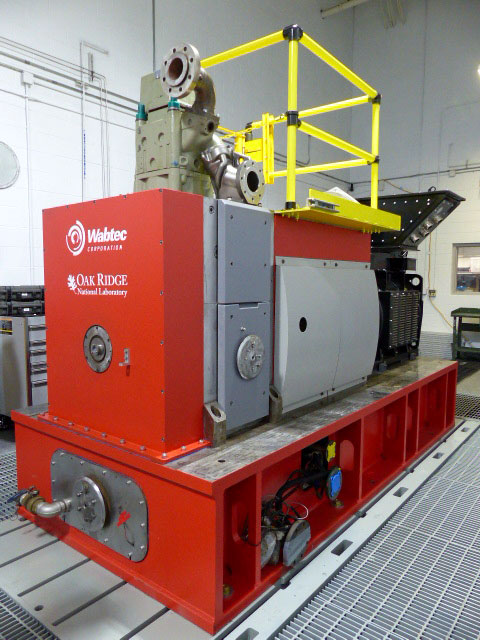
Rail is an energy-efficient way to ship products. One gallon of diesel fuel burned in a train can move one ton of goods about 480 miles, said Siddiq Khan, technology development manager in the U.S. Department of Energy’s Vehicle Technologies Office.
But diesel fuel produces carbon dioxide, a greenhouse gas, when it burns. Hydrogen does not. Instead, its combustion product is water. And the Biden administration has set a goal of reaching net-zero carbon emissions by 2050 as part of an international effort to cut greenhouse gas production to avoid the worst effects of climate change.
“The work we’re doing is very important,” said Dean Edwards, the project’s principal investigator at ORNL.
“We support the development of clean and safe energy technologies,” said Melissa Shurland, a program manager of research, development, and technology in the U.S. Department of Transportation’s Federal Railroad Administration.
“We all have the same mission, to decarbonize the rail sector,” said Jim Gamble, vice president of engine and power solutions technology for Wabtec Corporation, a locomotive manufacturer based in Pittsburgh, Pennsylvania. Besides being more energy-efficient, rail is a cleaner and safer form of transportation that keeps trucks off the road and reduces emissions, Gamble said. But more can be done as rail and freight are expected to more than double by 2050, he said.
ORNL said there are about 25,000 locomotives in use in North America, and the fleet emits about 87.6 billion pounds of carbon dioxide per year.
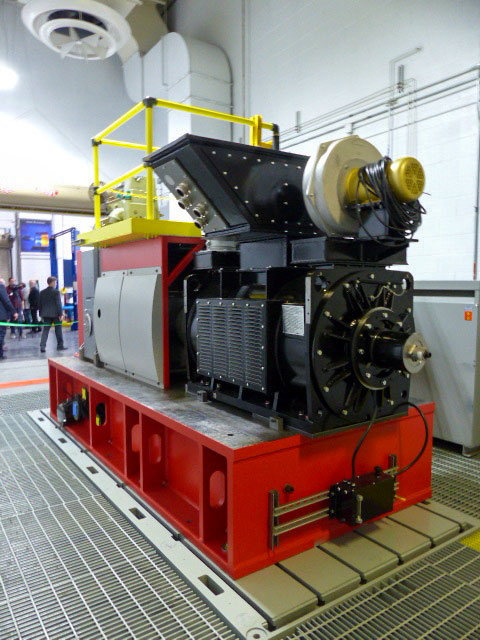
In the first phase of the lab’s engine project, the research team will work on hardware changes that would allow locomotives to be retrofitted. In the second phase, ORNL and Wabtec will continue to alter the engine hardware to increase the amount of hydrogen that can be used, the lab said.
“The team aims to completely replace diesel with hydrogen or low-carbon fuels in new locomotives,” ORNL said in a press release. The goal is to design train engines that will deliver the same power, range, and cost-effectiveness as current diesel technology.
Part of the project, researchers at Argonne will use computers to model and study hydrogen injection, combustion, and emissions. The researchers will include experts in fuel injection, kinetics and combustion modeling, optimal designs, high-performance computing, and machine learning. Argonne will use ORNL data in its computer modeling. The computer simulations will help researchers understand the combustion process. That, in turn, is expected to improve engine efficiency and reduce emissions. The simulations will help predict the behavior of combustion engines as operating conditions change and hardware is modified, ORNL said.
Argonne started its work in May, said Muhsin Ameen, senior research scientist at the lab.
Edwards said the engine at ORNL was rebuilt just before Halloween and set up in its space at the National Transportation Research Center in the past few weeks. The research motor has a dual-intake manifold. Hydrogen will be added to the cylinder before diesel, and when the diesel burns through compression, it will ignite the hydrogen.
Among the challenges will be preventing pre-ignition, or engine knock.
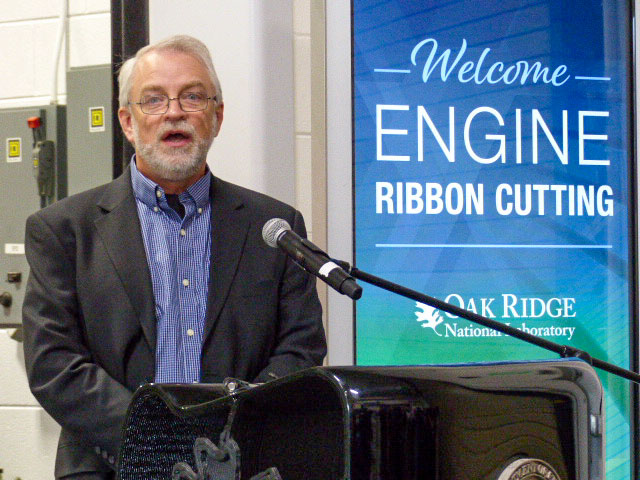
Although the initial focus is on hydrogen as a diesel substitute, other fuels that could be studied include renewable diesel and biodiesel. Researchers want to substitute as much diesel as possible with low-carbon fuels. ORNL said converting a diesel-powered locomotive to zero- or low-carbon fuel could prevent up to 5.6 million pounds of carbon dioxide emissions per year.
The research engine at the National Transportation Research Center could be running by spring, or as soon as possible, although there is additional setup to complete, including of coolant and air control systems, Edwards said.
But the engine is in place now.
“That was one of the big hurdles,” Edwards said.
ORNL said electrifying vehicles is an effective strategy to reduce carbon emissions from some parts of the transportation sector, but railways are considered more difficult because of the high cost of building a single coordinated electrified rail system across North America.
So, researchers are exploring the potential of hydrogen combustion engine technology in the rail industry. Hydrogen can be produced from clean energy sources such as solar and wind power, the ORNL press release said, and scientists have studied hydrogen-powered vehicles for decades.
“To reduce carbon dioxide emissions to net zero by 2050, we must make dramatic improvements in energy efficiency and emissions in the overall transportation system, including railways,” Ameen said. “Hydrogen has been used in light-duty combustion engines. However, hydrogen is a newer area of research in railway applications.”
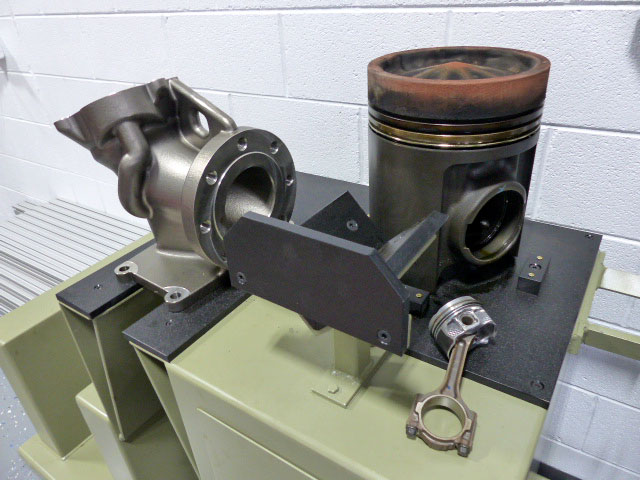
There are some concerns about hydrogen, though, including about emissions that could be released when is produced. This month, Inside Climate News reported that environmental advocates have argued for making hydrogen using renewable electricity and water, so-called “green hydrogen.” The hydrogen would be separated from oxygen through electrolysis, and oxygen would be the only emission.
But the oil and gas industry have been making a case for “blue hydrogen,” which uses natural gas and steam to produce hydrogen and carbon dioxide, Inside Climate News said. The goal would be to capture and store some of most of the carbon dioxide produced in this process. But there are questions about how much methane might leak, including from natural gas pipelines, and how much carbon dioxide would be captured during hydrogen production. Methane is a primary component of natural gas, and it is a powerful greenhouse gas.
Inside Climate News said the Inflation Reduction Act, enacted in August, included tax credits that would help finance hydrogen production.
(See this Inside Climate News article for more information.)
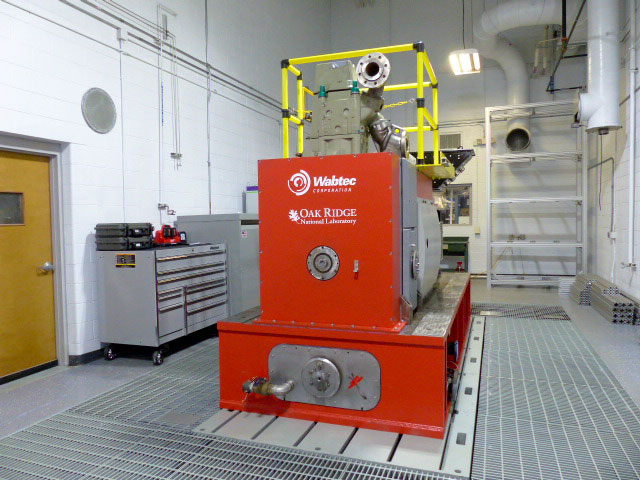
The rail engine research project at the National Transportation Research Center involves ORNL, ANL, Wabtec, DOE, FRA, and Convergent Science, a software developer.
Besides Pihl and Edwards, the ORNL team includes research engineer Eric Nafziger and research mechanic Steve Whitted.
Along with Ameen, the Argonne team includes group leader and principal research scientist Riccardo Scarcelli, postdoctoral fellow Samuel Kazmouz, and principal engine research scientist Christopher Powell.
The project is funded by the Vehicle Technologies Office under DOE’s Office of Energy Efficiency and Renewable Energy and by Wabtec. In-kind contributions are provided by Wabtec and Convergent Science. The U.S. Department of Transportation Federal Railroad Administration is also funding related research on safe use of hydrogen in locomotive engines.
More information will be added as it becomes available.
Thank you for your support!
Copyright 2022 Oak Ridge Today. All rights reserved. This material may not be published, broadcast, rewritten, or redistributed.
Leave a Reply